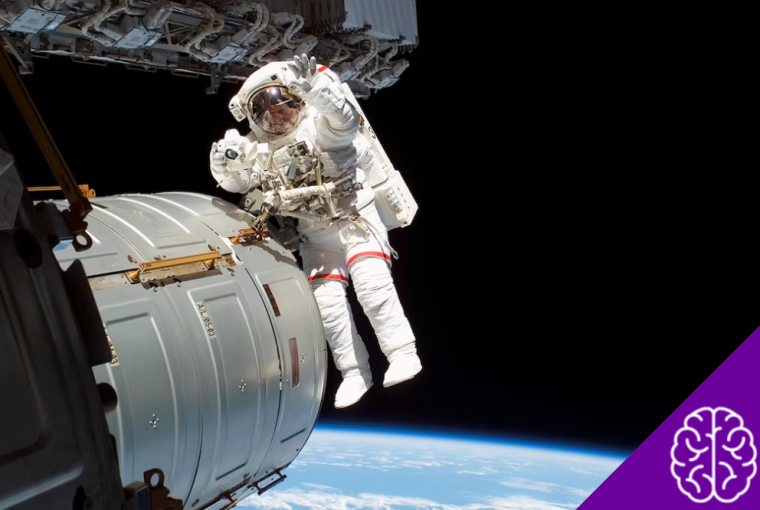Curious Facts About Astronauts: Life as an astronaut is a constant dance between scientific rigor and the simple, human need to eat, sleep, and stay healthy. While their work involves complex experiments and maintaining advanced spacecraft, many of the daily activities we take for granted on Earth become genuine challenges in the microgravity of space. From how they brush their teeth to how they sleep, every routine is adapted for an environment without gravity.
This unique setting gives rise to some fascinating quirks and solutions. The food is often dehydrated, baths are taken with damp towels, and even going to the bathroom requires a special procedure.
Yet, amid these challenges, astronauts find ways to live, work, and even have fun while orbiting our planet. This article explores 20 curious facts about the lives of these space travelers, shedding light on the realities of living beyond Earth’s atmosphere.
Life in Microgravity: Daily Routines
1. How Astronauts Brush Their Teeth
To brush their teeth, astronauts use a special apparatus fixed to a firm surface to prevent the toothbrush from floating away. They also use an edible toothpaste that is not too thick, as spitting it out is difficult in a microgravity environment.
2. Baths are Taken with Damp Towels
Taking a shower in space isn’t a simple task. Instead, astronauts rely on damp, soapy towels to clean themselves. This method of hygiene conserves water and prevents droplets from floating around the spacecraft.
3. They Eat Dehydrated Food
Most food taken to space is dehydrated to save weight and space. It needs to be rehydrated with hot water before being consumed.
This includes dishes like beans, fruits, and vegetables, as well as processed foods like cereals and cookies, all designed for easy preparation.
4. Astronauts Wear Diapers
During launches, landings, and spacewalks, astronauts wear adult diapers, known as Maximum Absorbency Garments. This is a practical solution for times when they cannot access a toilet for long periods.
5. They Must Exercise Two Hours a Day
To combat the negative effects of microgravity, such as bone and muscle loss, astronauts exercise for about two hours every day. This routine is essential for maintaining their physical health, cardiovascular system, and immune function during long-duration missions.
6. Toilets Require Special Restraints
Using the bathroom in space is a complicated affair due to the lack of gravity. Astronauts must strap themselves to the toilet to ensure they stay in place while using a system that employs suction to collect waste.
7. Sleeping Bags are Attached to the Wall
To sleep, astronauts use sleeping bags that are attached to a wall or another surface inside the International Space Station (ISS). This prevents them from floating around and bumping into equipment while they rest.
Health and Physical Effects of Space Travel
8. Hallucinations Can Occur
Astronauts can experience hallucinations in space. This is thought to be caused by a combination of factors, including sensory deprivation, isolation, and the effects of space radiation and microgravity on the nervous system.
9. Returning to Earth Can Be Difficult
Just as the body adapts to the absence of gravity, it must readjust upon returning to Earth. Many astronauts experience nausea, dizziness, and a feeling of heaviness as their bodies get used to gravity again.
10. Spacesuits Protect Against Extreme Temperatures
Astronauts’ suits are made of lightweight, durable materials and are designed to maintain a stable body temperature. In space, temperatures can fluctuate dramatically, so these suits are crucial for survival during spacewalks.
11. Gravity’s Absence Affects Health
The lack of gravity in space can lead to several negative health effects. Microgravity causes a loss of muscle mass and bone density, cardiovascular problems, changes in the immune system, and even vision problems, as the body adapts to functioning without Earth’s gravitational pull.
12. Blood Rushes to the Head
In space, the absence of gravity causes a redistribution of bodily fluids, with more blood flowing to the upper body and head. On Earth, gravity naturally pulls fluids downward, but in space, this balance is disrupted, often causing astronauts to have a puffy face and stuffy nose.
Fascinating Space Mission Facts
13. Why Objects Float in Space
Things float in space because of microgravity. While it seems like there is no gravity, the space station is actually in a constant state of freefall around the Earth. This creates the effect of weightlessness, causing unsecured objects (and people) to float.
14. Water is Recycled—Including Urine
On the ISS, 93% of water is recovered and reused. Astronauts use a sophisticated water recycling system that collects and treats urine, sweat, and even moisture from breath, turning it back into clean, drinkable water. This is vital for reducing the amount of resources that need to be sent from Earth.
15. The Record for Longest Time in Space
The record for the most cumulative time spent in space is held by Russian cosmonaut Oleg Kononenko, who has spent over 1,110 days in orbit.
The longest single spaceflight was by Valeri Polyakov, who stayed on the Mir space station for 437 days from 1994 to 1995.
16. The Different Names for Space Travelers
While “astronaut” is the most common term, space travelers from Russia are called “cosmonauts.” Similarly, those from China are known as “taikonauts.”
17. Coffee is Available in Space
Astronauts can enjoy coffee, but not in the traditional way. They use a special powdered coffee mixed with hot water. The beverage is prepared in a special pouch and sipped through a straw to prevent the liquid from floating away.
Becoming an Astronaut
18. Last US Astronaut Selection was in 2021
NASA’s most recent class of astronaut candidates was selected in 2021. This group of 10 individuals was chosen from a pool of more than 12,000 applicants to train for future missions.
19. Astronauts Perform Maintenance
A key part of an astronaut’s job is performing maintenance on space stations and their systems. They also conduct scientific experiments and monitor how the human body reacts to the space environment to help improve conditions for future missions.
20. The Requirements to Become an Astronaut
Becoming an astronaut requires meeting strict physical and mental criteria. Candidates typically need a university degree in a STEM field, professional experience, and excellent physical and mental health.
They must also undergo rigorous training that tests their endurance, communication skills, and ability to work as part of a team.
Exploring Our Universe!
The life of an astronaut is a blend of extraordinary challenges and groundbreaking science. From adapting simple daily routines to managing the profound physiological effects of space, every aspect of their existence is a testament to human ingenuity and our drive to explore.
As we continue to push the boundaries of space travel, the lessons learned from these pioneers will pave the way for future generations to venture even further into the cosmos.
The next time you look up at the night sky, remember the small community of humans living and working above, conducting experiments and maintaining a delicate habitat, all while floating in the vastness of space!


